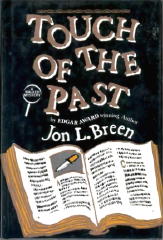September 2009
Monthly Archive
Tue 1 Sep 2009
Posted by Steve under
ReviewsNo Comments
THE BACKWARD REVIEWER
William F. Deeck
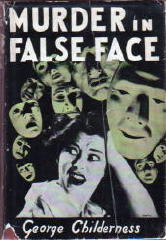
GEORGE CHILDERNESS – Murder in False Face.
Phoenix Press, hardcover, 1943. Hangman’s House Mystery #3, digest-sized paperback, “condensed slightly,” 1946. News Stand Library #125, pb; 1950.
Chet Phelps, assistant to Mr. Kent, first name undisclosed but publisher of twenty-odd newspapers, has some unusual duties. Preventing his boss from starving himself in the name of economy is foremost, but he also does some “stenography, reporting, killing of snakes (Denver), subornation of perjury (Milwaukee) and grave robbery in a southern city.”
After an evening of gambling and drinking, Phelps wakes up the next morning in bed with a young lady whose father had sued Kent for libel. Worse, Phelps discovers that during the night, a total blank to him, he married the young lady, her father had been murdered, probably strangled but also shot twice and horribly mutilated, after which the murderer had painted a false face on what was left of the corpse’s real face.
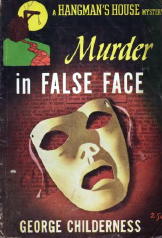
As usual, there are lots of suspects, all of whom seem to have been busy getting in each other’s way at the scene of the crime. Phelps investigates, when he isn’t busy getting sloshed. However, it is Kent, who has an odd fascination for waxing his nails, who discovers the murderer.
Nothing special here, though it has its amusing moments. Childerness wrote one more mystery, Too Many Murderers (Phoenix Press; 1944); maybe he got better.
– From The MYSTERY FANcier, Vol. 10, No. 3, Summer 1988.
Tue 1 Sep 2009
IT’S ABOUT CRIME
by Marvin Lachman
JON L. BREEN – The Gathering Place. Walker, hardcover, 1984; paperback, September 1986.
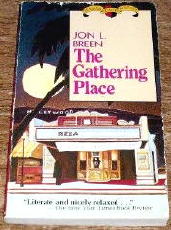
I’m on record as having serious reservations about occult and horror fiction, feeling most works in those genres are “copouts” in which the authors do not play by the “rules” of reality.
Jon L. Breen’s The Gathering Place contains one unexplainable element, the ability of its heroine, Rachel Hennings, to, without practice, imitate the signatures of famous authors like ErIe Stanley Gardner. The plot device of automatic writing doesn’t help what is otherwise a classic detective story, but it doesn’t hurt it enough to keep me from recommending thls book.
The setting is a famous old bookstore, on Santa Monica Boulevard in Los Angeles, recently inherited by Hennings from her uncle. There is real murder to go with the supernatural, and soon Rachel is acting as detective, with some help from a psychology professor, a reporter, and a Los Angeles Police detective.
Hennings is a, strong enough character that she probably doesn’t need that many extra detectives. The mystery is crisply told and satisfactorily resolved, by strictly logical means. A real bonus is the atmosphere of an old-fashioned book store as seen through the eyes of an author who obviously loves old books.
– From The MYSTERY FANcier, Vol. 9, No. 2, March/April 1987.
Bibliographic Data. [Expanded from the Revised Crime Fiction IV, by Allen J. Hubin.]
HENNINGS, RACHEL
The Gathering Place. Walker, hc, 1984.
A Piece of the Auction. EQMM, July 1986. [Short story.]
Starstruck. Murder in Los Angeles, Adams Round Table, Morrow, 1987. [novelette]
Touch of the Past. Walker, hc, 1988.
Rachel and the Bookstore Cat. Danger in D.C., ed. Martin H. Greenberg & Ed Gorman, Donald I. Fine, 1993. [short story]
Tue 1 Sep 2009
Posted by Steve under
Reviews[5] Comments
A REVIEW BY DAVID L. VINEYARD:
CRAIG RICE – Trial by Fury. Simon & Schuster, hardcover, 1941. Paperback reprints include: Pocket 237, 1st printing, October 1943. Dell D187, Great Mystery Library #2, 1957. International Polygonics, 1991.
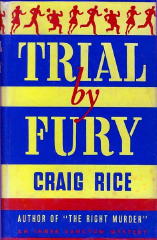
When Jake and Helene Justus escape the hot summer in Chicago, they find themselves in the Jackson County Court House in Jackson, Wisconsin, just in time to witness the murder of ex-Senator Joseph Peveley (“It can’t be murder, that’s the second murder in thirty-two years.”), and naturally Jake being Jake, he ticks off the less than brilliant local lawman and finds himself jailed as a material witness. “It’s none of my business, and I don’t know that I care very much, but who might have wanted to murder your ex-Senator?”
So the leggy blonde Helene does what any sensible wife would do. She sends to Chicago for that rumpled, red haired, bibulous Don Quixote of the law, the one and only John J. Malone, defender of the weak, savior of the downtrodden, and patron of more bars than the Bar Association can shake a stick at, who arrives by bus, hot bothered, and as usual brilliant.
In fact, before he even gets Jake and the local prosecutor (who has been arrested by the same lawman) out of jail, he finds the murder weapon and shows how the crime was committed.
Now all he wants to do is get himself out of Jackson and back to noisy, hot Chicago: “Here they are living in the age of innocence, and in Chicago were living in the age of consent.”
But then when he goes to cash a check and they blow the bank out from under him, it delays his departure.
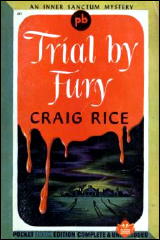
“You’re not dead,” Helene said.
Malone shut his eyes again. “I am too dead,” he told her.
But he isn’t, though someone else is, and as the doctor remarks the city has about four murders every thirty-two years. “There’s two more coming.”
So reluctantly Malone finds himself delving into the case, and being Malone he naturally does it between drinks, with a little help from a local who seems to be under the impression Hoover is still in office and Prohibition is still in effect:
“The liquor is a little different here too.”
“Don’t you like it?”
“I like it, but it has a way of sneaking up on you when you don’t expect it …”
And before long, there is yet another murder, one which is preceded by Malone jumping in a river to save a damsel in distress; a body found buried under a concrete slab in a most respectable basement; a less than respectable young lady is killed; and Jake ends up running from a lynch mob with Malone and a slightly inebriated bloodhound named Hercules on his trail, with a bottle of Dollar Gin their only clue.
Of course Malone solves it, if only after polishing off the Dollar Gin and the local madhouse burns down while he and Hercules send a lynch mob packing.
“Do you want to go to your grave with the blood of an innocent man on your hands for a lousy ten bucks apiece?”
In the same instant, Hercules, somewhere in the bushes beyond sent up a heart rending howl.
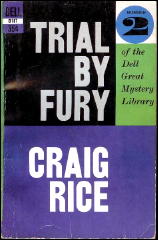
An uneasy, frightened movement began in the crowd, slowly men began pulling away in little groups and starting for their cars. A piece of loose tender in the burning building behind Malone suddenly blazed up and sent an unearthly light over the scene. In the same instant Hercules let loose with another dreadful howl, and the movement toward the parked cars became a panicked rout.
Malone spun around and threw the cigar in the smoldering flames. There wasn’t much difference, after all, between a lynch mob and a jury in a criminal court. You could convince ’em, or you could reason with ’em, or you could pray with ’em, but the simplest thing to do was to scare ’em. He wished he could take Hercules into a courtroom with him sometime.
Trial by Fury may well be Rice best novel in the Malone opus. It is funny, involving, fast moving, the detective work is genuine, and the humor never flags or falls flat.
The characters belong to that bucolic Hollywood version of an America that never existed, but Rice and Malone both know that under that facade of 4th of July picnics and Sunday morning services there are motives and actions enough for murder most foul.
Jake is his usual less than bright self, and Helene surely the most beautiful wife a lucky fool could have. Malone sulks, pouts, drinks, smokes his cigars, looks rumpled, and proves brilliant and in this one even falls in love — albeit with an unlikely soul mate — Hercules, a giant half Bloodhound, half Great Dane, who is possessed of a courageous soul and a detective’s unwillingness to ever give up the scent.
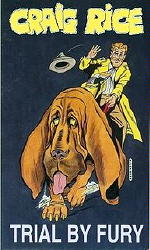
It was just as they drove under the elevated that Malone snuggled back against the seat cushion and closed his eyes. Two seconds later he was asleep, a seraphic smile on his face.
“What do you suppose he’s dreaming about?” Helene asked.
“Who, Malone or Hercules?”
She looked down at the sleeping pair and shook her head.
“I wonder how that dog found his way into the car?” she mused.
Jake took her free hand in his and looked at her tenderly.
“Love,” he said. “Will always find a way.”
And in all honesty, I don’t think I can top that. Find this one and read it. It is the screwball school personified, a first class piece of detective work, a drop dead funny novel, and Malone and Hercules are one of the great romances in literature. Unless you are a cat person, or have a heart of stone.
Tue 1 Sep 2009
Some odds and ends this time, almost of them dealing with small typographical errors that have been spotted and corrected in Part 34 of the online Addenda to the Revised Crime Fiction IV, by Allen J. Hubin.
COBB, (GEOFFREY) BELTON. 1892-1971. Son of Thomas Cobb, 1835-1932, q.v. Sales director for Longman’s publishers and a regular contributor to Punch and other magazines. His detective novels invariably involved one or more of three series characters: Inspector Cheviot Burmann (41 titles), Bryan Armitage (21 titles) and Superintendent Manning (6 titles), with some overlap. A small handful of stand-alone novels are also included in his entry in the Revised Crime Fiction IV.
DEHAN, RICHARD. Pseudonym of Clothilde (Inez Augusta Mary) Graves, 1863-1932, q.v. Under this pen name, the author of two story collections included in the Revised Crime Fiction IV; some of the stories are criminous.
FORSYTE, CHARLES. Joint pseudonym of Gordon Charles George Philo, 1920-2009, and his wife Mavis Ella (Galsworthy) Philo, 1920-1986, qq.v. Under this pen name, the author of four crime and/or espionage novels included in the Revised Crime Fiction IV, three of them cases for Inspector Richard Left. Of special note is the following book, also in his CFIV entry:
The Decoding of Edwin Drood. Gollancz, UK, hc, 1980; Scribner, US, hc, 1980. Discussion of previous attempts to complete the novel by Charles Dickens, 1812-1870, with a new ending by this author.
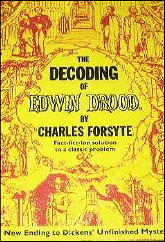
GRAVES, CLOTILDE (INEZ AUGUSTA MARY). 1863-1932. Add name in full (first named sometimes spelled Clothilde). Pseudonym: Richard Dehan, q.v. Born in Cork; actress, journalist, illustrator, poet and playwright. Under her own name, the author of one title included with a dash in the Revised Crime Fiction IV. See below. Other work, according to one source includes “humorous novels and stories of witchcraft and pagan religions.”
-Dragon’s Teeth. Dalziel Brothers, UK, hc, 1891. Add setting: China. [A tale of daring adventure, hardship and love in China during a native uprising.]
HAMILTON, [LORD] FREDERIC (SPENSER). 1856-1928. Add biographical information: Was in Diplomatic Service, serving in Berlin, Petrograd, Lisbon and Buenos Aires. Member of Parliament; editor of Pall Mall Magazine. (Some sources say that he introduced the sport of skiing to Canada in 1887.) The author of one standalone novel in the Revised Crime Fiction IV, plus seven story collections involving series character Mr. P. J. Davenant. One of these is shown below (Nash, 1915). According to Lofts & Adley, Philip John Davenant was “a public school boy [whose] adventures took place while he was still a pupil at Tonbridge School […] In addition to an amazing bent to criminology [he had] a wonderful knowledge of the German language.”
-Lady Eleanor, Private Simmonds, and Others. Hurst, UK, hc, 1919. Correct setting: Ireland.
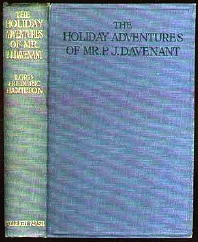
HARDY, IZA DUFFUS. Ca.1852-1922. The author of “a large output of novels of a romantic cast. She set some of them in exotic places, and also wrote travel books and contributed stories and other pieces to periodicals.” To the thirteen titles previously listed in the Revised Crime Fiction IV, add the one below.
Friend and Lover. Hurst, UK, hc, 1880; Harper, US, hc, 1880. Setting: England.
MACKENZIE, JOAN (NOBLE). Correct spelling of last name (from MacKenzie) and add middle name. Add: Born in Dumfries, Scotland, 1905. Included in her entry in the Revised Crime Fiction IV are five titles published between 1935 and 1951, four of them indicated as having only marginal crime content.
PHILO, GORDON CHARLES GEORGE. 1920-2009. Add year of death and biographical information: British diplomat stationed in Hanoi, Kuala Lampur, Ankara, Istanbul and London; long-time member of Britain’s Secret Intelligence Service. In literary circles, an expert on both Charles Dickens and Rudyard Kipling. Joint pseudonym with his wife Mavis Ellen Galsworthy Philo, 1920-1986: Charles Forsyte, q.v.
PHILO, MAVIS ELLEN (GALSWORTHY). 1920-1986. Add both dates and full name. Joint pseudonym with husband Gordon Charles George Philo, 1920-2009: Charles Forsyte, q.v.
SCOTT, EVELYN. 1893-1963. Pseudonym: Ernest Souza, q.v. Born in Clarksville, Tennessee; name at birth: Elsie Dunn. She changed her name to Evelyn Scott in 1913 when she began living with Frederick Creighton Wellman, an already married dean at Tulane University. After the mid-20s, she married British writer John Metcalfe. A celebrated novelist, playwright and poet of her day.
SOUZA, ERNEST. Pseudonym of Evelyn Scott, 1893-1963, q.v. Under this pen name, the author of one adventure thriller included in the Revised Crime Fiction IV. See below:
Blue Rum. Cape & Smith, US, hc, 1930; Jonathan Cape, UK, hc, 1930. Setting: Portugal, Brazil (add the latter).
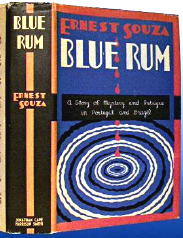
« Previous Page



